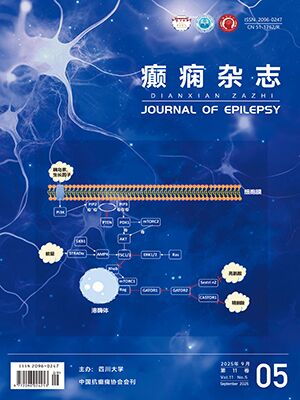| 1. |
Mirandola L, Mai RF, Francione S, et al. Stereo-EEG: diagnostic and therapeutic tool for periventricular nodular heterotopia epilepsies. Epilepsia, 2017, 58(11): 1962-1971.
|
| 2. |
中国医师协会神经外科分会功能神经外科学组, 中国抗癫痫协会, 国家神经外科手术机器人应用示范项目专家指导委员会. 立体定向脑电图引导射频热凝毁损治疗药物难治性癫痫的中国专家共识. 中华医学杂志, 2021, 101(29): 2276-2282.
|
| 3. |
Khoo HM, Gotman J, Hall JA, et al. Treatment of epilepsy associated with periventricular nodular heterotopia. Curr Neurol Neurosci Rep, 2020, 20(12): 59.
|
| 4. |
Cvetkovska E, Martins WA, Gonzalez-Martinez J, et al. Heterotopia or overlaying cortex: What about in-between? Epilepsy Behav Case Reports, 2019, 11: 4-9.
|
| 5. |
Cossu M, Fuschillo D, Casaceli G, et al. Stereoelectroencephalography-guided radiofrequency thermocoagulation in the epileptogenic zone: a retrospective study on 89 cases. J Neurosurg, 2015, 123(6): 1358-1367.
|
| 6. |
Cossu M, Mirandola L, Tassi L. RF-ablation in periventricular heterotopia-related epilepsy. Epilepsy Res, 2018, 142: 121-125.
|
| 7. |
耿俊红, 侯群, 蒋艳. 脑室旁结节状灰质异位相关癫痫的研究进展. 中华神经医学杂志, 2021, 20(9): 960-962.
|
| 8. |
邓馨, 王利霞, 王薇薇, 等. 灰质异位伴癫痫发作5例报告及文献复习. 中风与神经疾病杂志, 2019, 36(8): 743-745.
|
| 9. |
邓馨, 王薇薇, 吴逊. 灰质异位与癫痫发作. 癫痫杂志, 2018, 4(6): 497-504.
|
| 10. |
刘文钰, 安东梅, 周东. 中国西部70例室管膜下型灰质异位症伴癫痫患者的回顾性研究. 癫痫杂志, 2017, 3(6): 459-464.
|
| 11. |
Liu W, Yue Q, Tian Y, et al. Neural functional connectivity in patients with periventricular nodular heterotopia-mediated epilepsy. Epilepsy Research, 2021, 170(1247): 106548.
|
| 12. |
林绍鹏, 邓宇虹, 刘晓蓉, 等. 双侧脑室旁结节状灰质异位症患者11例影像与临床研究. 中华神经科杂志, 2008, 41(1): 29-32.
|
| 13. |
刘畅, 王亮, 桑林, 等. 立体脑电图引导射频热凝毁损治疗脑室旁结节状灰质异位相关癫痫. 中华神经外科杂志, 2018, 34(12): 1222-1226.
|
| 14. |
华刚, 谭红平, 姜楠, 等. SEEG引导下射频热凝毁损术在癫痫外科中的应用. 立体定向和功能性神经外科杂志, 2020, 33(2): 69-73.
|
| 15. |
Alis C, Alis D, Uslu Besli L, et al. The analysis of 18 F-FDG PET/MRI, electroencephalography, and semiology in patients with gray matter heterotopia: a pilot study. Acta Neurol Scand, 2022, 146(5): 662-670.
|
| 16. |
Barkovich AJ, Guerrini R, Kuzniecky RI, et al. A developmental and genetic classification for malformations of cortical development: update 2012. Brain A Journal of Neurology, 2012, 135(5): 1348-1369.
|
| 17. |
Kahane P , Elisabeth Landré, Minotti L , et al. The Bancaud and Talairach view on the epileptogenic zone: A working hypothesis. Epileptic disorders: international epilepsy journal with videotape, 2006, 8 (suppl 2): S16-26.
|
| 18. |
Bourdillon P, Cucherat M, Isnard J, et al. Stereo-electroencephalography-guided radiofrequency thermocoagulation in patients with focal epilepsy: a systematic review and meta-analysis. Epilepsia, 2018, 59(12): 2296-2304.
|
| 19. |
Battaglia G, Chiapparini L, Franceschetti S, et al. Periventricular nodular heterotopia: classification, epileptic history, and genesis of epileptic discharges. Epilepsia, 2010, 47(1): 86-97.
|
| 20. |
Li LM, Dubeau F, Andermann F, et al. Periventricular nodular heterotopia and intractable temporal lobe epilepsy: poor outcome after temporal lobe resection. Ann Neurol, 1997, 41(5): 662-668.
|
| 21. |
Khoo HM, von Ellenrieder N, Zazubovits N, et al. Internodular functional connectivity in heterotopia-related epilepsy. Ann Clin Transl Neurol, 2019, 6(6): 1010-1023.
|
| 22. |
Aghakhani Y, Kinay D, Gotman J, et al. The role of periventricular nodular heterotopia in epileptogenesis. Brain, 2005, 128(3): 641-651.
|
| 23. |
Tassi L, Colombo N, Cossu M, et al. Electroclinical, MRI and neuropathological study of 10 patients with nodular heterotopia, with surgical outcomes. Brain, 2005, 128(2): 321-337.
|
| 24. |
Thompson SA, Kalamangalam GP, Tandon N. Intracranial evaluation and laser ablation for epilepsy with periventricular nodular heterotopia. Seizure, 2016, 41: 211-216.
|




